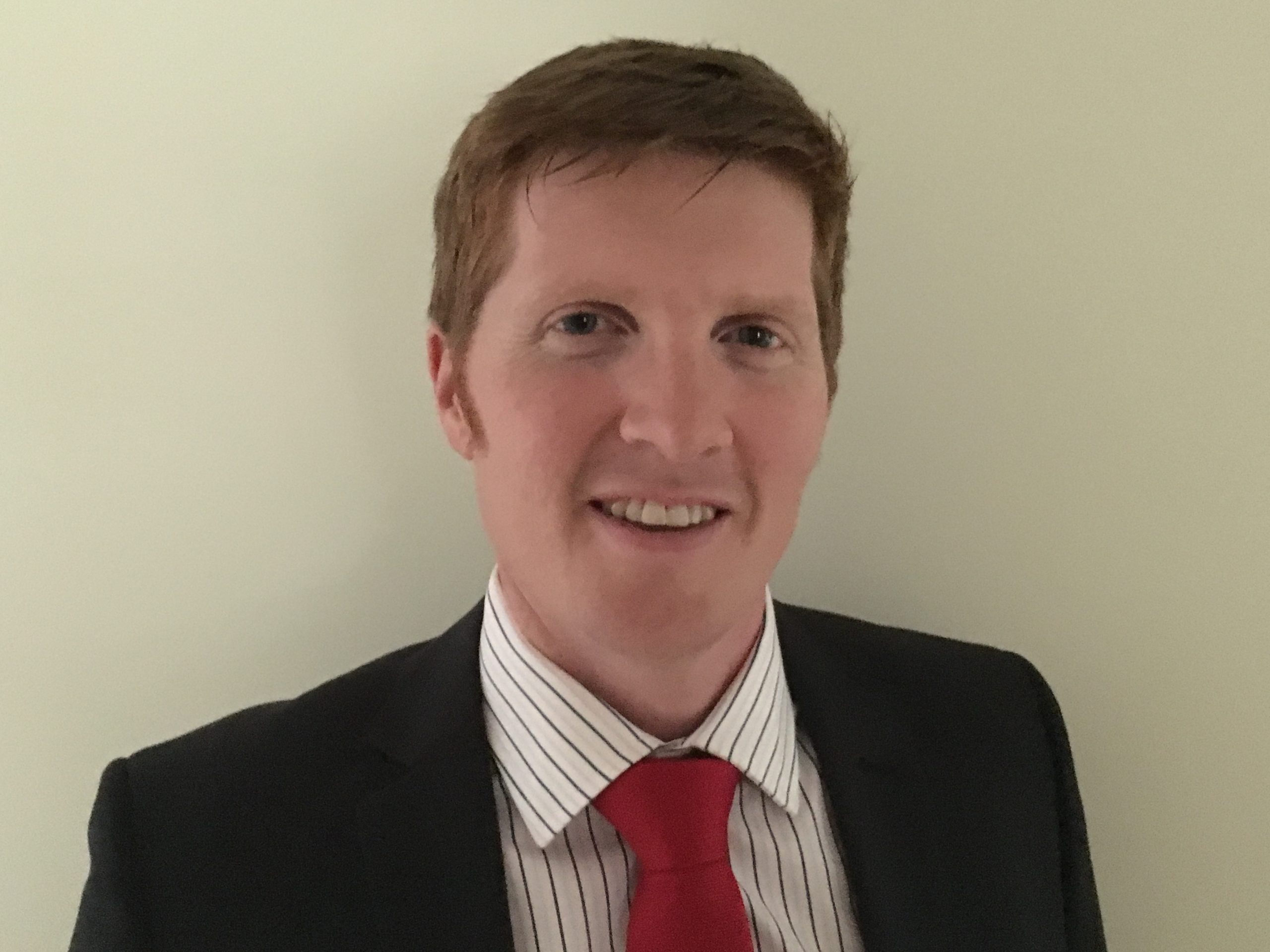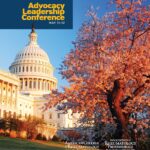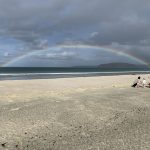We write to celebrate the life of Philip C. Robinson, MB ChB, PhD, FRACP, a beloved colleague and leader in rheumatology. Phil died in early January after an unexpected and short illness. He is survived by his wife, Helen, and his two young sons.
We have witnessed an incredible outpouring of respect and affection for Phil from all over the world. This reflects the positive influence Phil had on so many and the esteem to which he was held among rheumatologists.
Phil’s Early Career in Medicine
At age 17, Phil started at Otago Medical School in Dunedin, New Zealand. He once told us that he was the last one into his medical school class, and he was also a late entry. He relayed that he got an offer of a place some weeks into the academic year after a withdrawal. Phil later reflected: “I thought I wanted to be a pharmacist, but on getting to university, medicine seemed much cooler, so I decided to do that. I was the last one into my medical class, so by the skin of my teeth.” He told us that the whole situation was a lucky break. We think medicine got the lucky break.
Phil graduated with New Zealand’s medical degree, an MB ChB, in 2002. He then completed internships and basic physician training in his hometown of Wellington, the capital city of New Zealand. His rheumatology training was undertaken at Wellington Regional Rheumatology unit and then in Dunedin.
Phil was an outstanding trainee. One of us, Rebecca, supervised him and recalls being impressed that he recorded CDAI or SDAI on all his patients with rheumatoid arthritis when most of the consultants (attendings) did not. When Rebecca asked Phil why he used the CDAI rather than the more common DAS-28, he quoted a paper by Joseph Smolen that supported his choice—typical Phil style.
Phil also took every scholarly opportunity and started in research during his training. By the time he completed rheumatology training he had published at least six peer-reviewed manuscripts.
He moved to Brisbane, in Queensland, Australia, in 2010 to undertake a PhD in Matt Brown’s lab, examining the genetics of ankylosing spondylitis. This was followed by a post-doctoral fellowship at the University of Queensland. He was a successful researcher and excellent collaborator, focusing on gout and axial spondyloarthritis.
Phil was known to be generous with his ideas and time, often emailing or texting research ideas, interesting articles or podcasts. These messages were notable for their relentless positivity and energy.
Phil also had a strong service ethic and volunteered in many roles to support his peers and the profession. These included roles in rheumatology and physician training for the Royal Australasian College of Physicians and for the Australian Rheumatology Association and its Queensland branch, as well as organizing state conferences. All of these efforts were unpaid. Phil managed to juggle this work with a busy clinical practice and research.
Meeting International Colleagues at the ACR
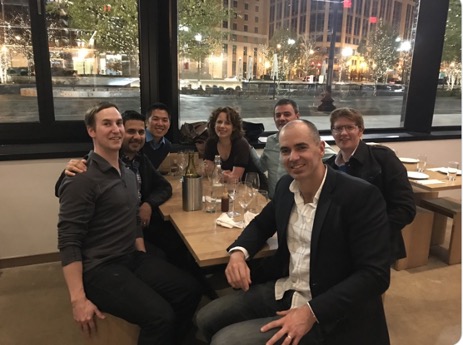
One of our Twitter friend catch-ups at the 2014 ACR annual meeting. From left: Paul Sufka, Suleman Bhana (both U.S.), Irwin Lim (Australia), Rebecca Grainger (New Zealand), Ronan Kavanagh (Ireland), Phil Robinson, Sam Whittle (Australia).
Going to the ACR annual meeting was always a highlight for Phil. He wrote in a blog, “My experience of annual American meetings was fantastic, and it keeps getting better: I have been to Philadelphia (#ACR09) and Washington, D.C. (#ACR12). I had to miss #ACR10 because of my wedding, as the Atlanta location for the honeymoon was vetoed by my darling Helen.”
Phil went on, with his unflappable enthusiasm, to say, “It was fantastic meeting up with a whole lot of people I have only known from Twitter.” Three of us, Paul, Suleman and Rebecca, were part of those Twitter friend catch-ups at the ACR annual meetings. Wonderful friendships were forged with Phil.
Phil had an insatiable appetite for learning from others and for research. He was an extremely productive researcher and enjoyed presenting his work at ACR annual meetings. He put it best: “It is such a good meeting to get good feedback on what you are doing and additional ideas. I was also able to meet other researchers who inspire me to be all I can.”
Despite being on the other side of the world, the early friendships Phil established continued between meetings. Phil stayed connected through technology, especially on Twitter. One of us, Suleman, notes that he was astounded how down to earth and humbly Phil carried himself, even while he was becoming an internationally known researcher in gout and spondyloarthritis. He carried no pretense and saw the best in people even when they did not see it themselves.
Creating the COVID-19 Global Rheumatology Alliance (GRA)
On March 11, 2020, the World Health Organization declared COVID-19 a pandemic. Phil was on holiday at the time. In an article for The Rheumatologist, he wrote that he was “standing on an idyllic, windswept beach in northern New Zealand, but I couldn’t focus on the rainbow. I had a pandemic on my mind. There were growing dark clouds in the world.”
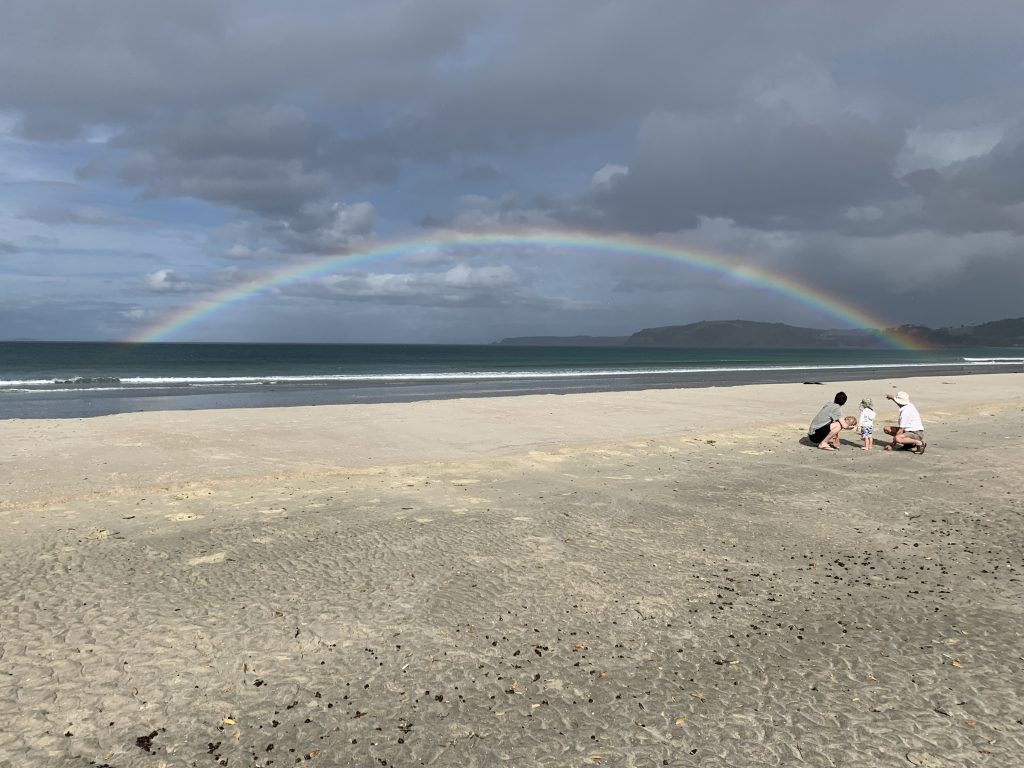
A symbol of hope the world over, the rainbow pictured here was witnessed by Phil Robinson on March 11, 2020, on a beach in northern New Zealand. / photo by Philip C. Robinson
Phil was following a conversation on Twitter initiated by Leonard H. Calabrese, DO, FACR, a rheumatologist at the Cleveland Clinic, about an effort by gastroenterologists to establish a COVID-19 outcomes registry for patients with inflammatory bowel disease. Len had tweeted, “Totally smart thing to do—Are we doing this in rheum?” Through Twitter, Phil connected with international colleagues who were interested in rising to Len’s call. One Zoom conference with Jinoos Yazdany and her team at the University of California, San Francisco later, Phil and Jinoos, who had never met before, had a plan for how to put a registry together.
While Jinoos and her team stood up the research database, wrote institutional review board applications and engaged the ACR for support, Phil worked his magic to establish collaborations. As the email list expanded, he asked Suleman to create a Slack group, which at its peak had close to 250 members. He also asked Paul to create a webpage and Twitter handle (@rheum_covid) to get the larger scientific community involved. By March 15, only a few days later, 137 rheumatologists had been recruited and, remarkably, @rheum_covid had 863 followers.
Paul relates that he exchanged hundreds of direct messages with Phil around this time and that his favorite message from Phil was on March 20, 2020: “It is really great to see something so positive and collaborative come out of what is a world-wide crisis in health and healthcare. I feel like I am making a meaningful contribution.”
Like Phil, rheumatologists around the world felt a collective urgency to provide information for their patients. Phil was able to harness not only the collective anxiety, but also our deep desire to connect and collaborate. Phil worked tirelessly those first few months, often waking in the early morning hours for international meetings and interacting with everyone through Slack. He helped the GRA raise funds to support the research effort and suggested we form a steering committee to oversee the effort.
Phil was an innovator, working with patients to embed patient partnership throughout the GRA. On March 12, 2020, Phil responded to a Tweet from patient partners asking to combine efforts and join the leadership of the GRA to learn about the effects of COVID-19 on people with rheumatic diseases. He introduced patients to rheumatologists to create global collaborations that would ultimately improve the work of the GRA. His open-minded, supportive and charismatic nature welcomed patients into the organization and provided a safe space for them to engage in research and provide their insight into the effects of the pandemic. His support of patients extended to establishing a Patient Board, enabling the development of the largest patient-led survey in rheumatology regarding the pandemic, and international patient engagement.
One of us, Jon, who led the patient efforts with Emily Sirotich, notes, “In looking back at these experiences, I can see the wisdom of someone well beyond his years, with an intuitive sense for people and their relationship to science. What I most admired about Phil was his incredible leadership skills; early on, the GRA was a hodgepodge of different people with different backgrounds who all wanted to advance the care of people with rheumatic disease during the pandemic. Somehow, he was able to organize this motley crew into various teams, and he empowered each team to work independently to achieve our goals.”
Phil also reached out to EULAR; due to general data protection regulations (GDPR) in the European Union, Europe needed a separate, parallel registry. One of us, Pedro, who was the chair of the EULAR Standing Committee on Epidemiology and Health Services Research at that time, remembers Phil’s commitment, enthusiasm, vision and collegial approach. These were key to the success of the GRA/EULAR partnership. The EULAR COVID-19 registry was launched via a REDCap platform on March 20, 2020, mirroring the UCSF global registry.
Phil was highly esteemed within the EULAR community. Pedro comments that he feels privileged to have worked with such an amazing colleague, researcher and human being, and to have witnessed Phil’s exceptional leadership skills: “Phil had extraordinarily good judgment, integrity, scientific knowledge and exemplary interpersonal and communication skills. He valued the opinions of others and understood the power and the need for diversity and inclusion. He nurtured young colleagues and valued patient input.”
The first few months of the GRA were grueling, but Phil’s endless enthusiasm and sense of mission kept everyone motivated. With rheumatologists all over the world generously entering cases, and trainees and junior faculty volunteering thousands of hours to interpret data and write papers, the GRA quickly started producing publications. The GRA has had more than 40 publications, and Phil was a key to every single one. Under Phil’s leadership, the products of the GRA shaped the practice of rheumatology clinicians around the world during a time of tremendous uncertainty.
Mentorship & Collaboration with Diversity & Inclusion in Mind
At the inception of the GRA, Phil had a clear vision for recruiting volunteers based on their experience and expertise to lead focused projects. Although the physician registry was our main activity, he also supported a registry of patients to better understand the patient experience during the pandemic and several literature reviews to address urgent questions for the rheumatology community.
These teams were led by GRA members who came to be termed the Clinical and Scientific Subcommittee (CASC), all of whom were in varying stages of early career. This led to a pay-it-forward mentoring approach. Each project’s leaders—who were intentionally early career at Phil’s urging—took on roles organizing large teams of volunteers from around the world, with varied experience, to perform rigorous research rapidly. Some volunteers were trainees without research experience, and those with more experience took on the responsibility of guiding them.
We were able to achieve so much because Phil believed it could all be done and gave each of us the encouragement and direction—but also the freedom—to make it happen. Phil’s leadership gave purpose in a tremendously uncertain time.
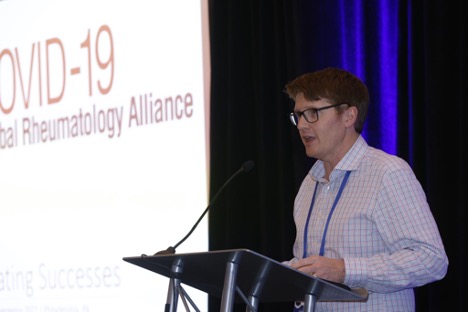
Phil Robinson giving opening remarks to members of the COVID-19 Global Rheumatology Alliance at their first in-person event at ACR Convergence in 2022.
It is striking how many GRA members, other early career rheumatology clinicians and researchers have expressed their gratitude for his mentorship and support when remembering Phil. Jean, who was a third-year fellow at the time of the GRA’s creation, and Zach note that Phil’s guidance and knack for collaboration propelled their careers forward during a difficult and uncertain time when some of their usual research was halted. It was a hard time for everyone, but especially for trainees and early faculty, who were navigating career transitions in the middle of the pandemic. Through the GRA, many rheumatologists found new collaborators and developed novel ideas that will forever change their careers.
Ironically, during a time when so many of us were isolated from one another, Phil’s idea to take a chance and build what would become the GRA brought many of us together for the first time ever. He connected us in ways we never thought would be possible and for that we are forever indebted to him. None of our accomplishments would have been possible without Phil’s belief in each of us, his belief that we had something unique to offer to the GRA and to rheumatology in general. He saw something in us and knew that ordinary people could do extraordinary things if given the space and resources to achieve them.
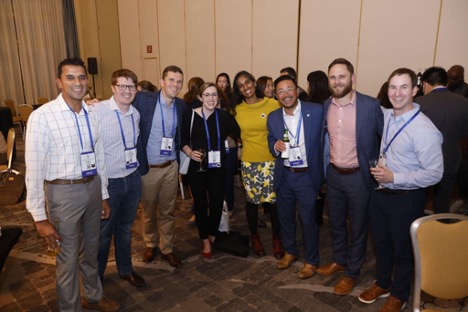
Members of the COVID-19 Global Rheumatology Alliance at their first in-person event at ACR Convergence 2022 in Philadelphia.
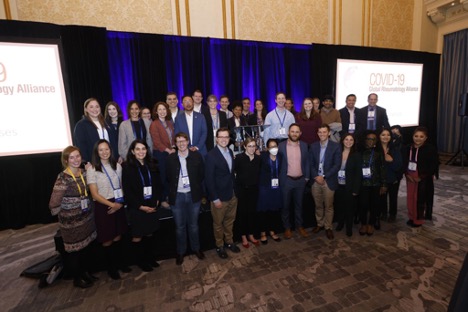
Members of the COVID-19 Global Rheumatology Alliance at their first in-person event at ACR Convergence 2022 in Philadelphia.
And it’s not just that Phil’s leadership opened the door for us, career-wise. The colleagues we met through the GRA are now good friends and peer mentors, even the ones we finally met in person after nearly three years, at ACR Convergence 2022.
Conclusion
Phil’s life was too short. But we are all so lucky to have known him, learned from him, worked with him and built the GRA under his leadership. As a community, we are forever indebted to him for the studies that shaped the way we navigated this pandemic with our patients. Perhaps most importantly, we are also indebted to him for the lessons he taught us about thinking big, collaborating with others, embracing uncertainty and having fun while doing it.
Share Your Condolences
If you would like to share your memories of Phil with his family and colleagues, you can visit the page established by the Australian Rheumatology Association or send an email with text or photos to Jean Liew.
The COVID-19 Global Rheumatology Alliance: Its Genesis, Development & Goals
